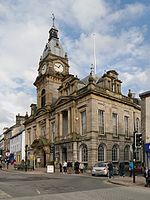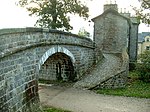Abbot Hall Art Gallery

Abbot Hall Art Gallery is an art gallery in Kendal, England. Abbot Hall was built in 1759 by Colonel George Wilson, the second son of Daniel Wilson of Dallam Tower, a large house and country estate nearby. It was built on the site of the old Abbot's Hall, roughly where the museum is today. Before the Dissolution of the Monasteries this was where the Abbot or his representative would stay when visiting from the mother house of St Mary's Abbey, York. The architect is unknown. During the early twentieth century the Grade I listed building was dilapidated and has been restored as an art gallery. As of January 2021 Abbot Hall was closed to the public while Lakeland Arts carried out a redevelopment of the building and grounds. The reopening is on 20 May 2023 with an exhibition by Julie Brook.
Excerpt from the Wikipedia article Abbot Hall Art Gallery (License: CC BY-SA 3.0, Authors, Images).Abbot Hall Art Gallery
Church Walk,
Geographical coordinates (GPS) Address Phone number Website External links Nearby Places Show on map
Geographical coordinates (GPS)
| Latitude | Longitude |
|---|---|
| N 54.323055555556 ° | E -2.7438888888889 ° |
Address
Abbot Hall Art Gallery
Church Walk
LA9 5AL , Kirkbarrow
England, United Kingdom
Open on Google Maps









